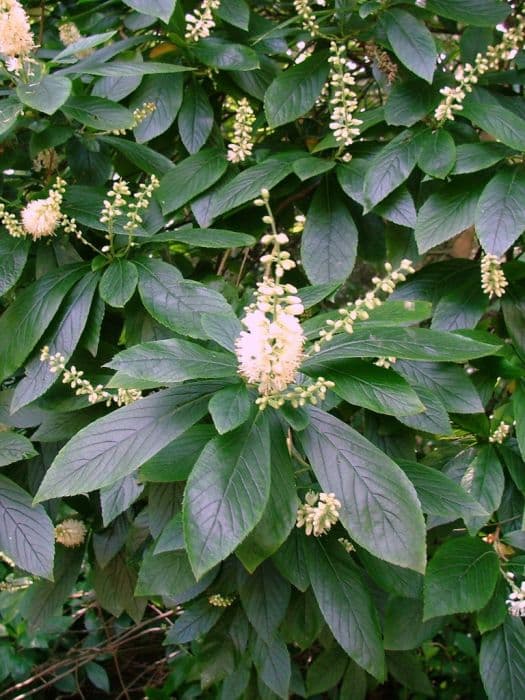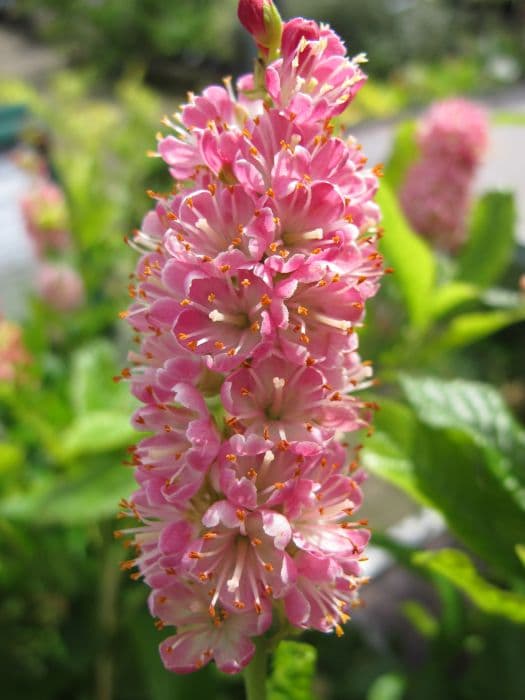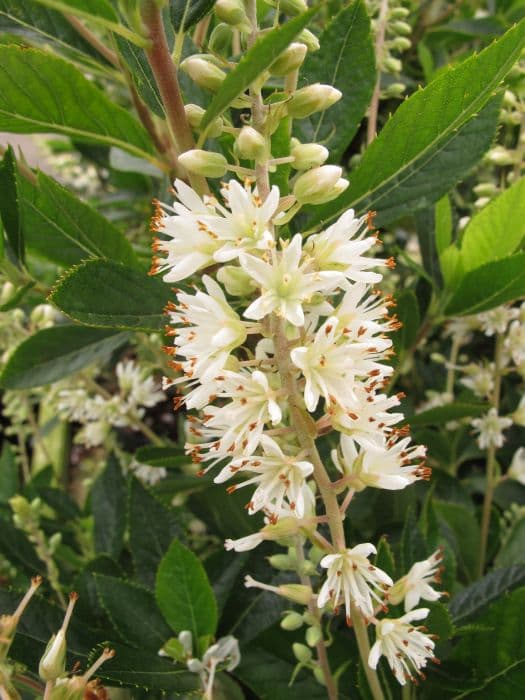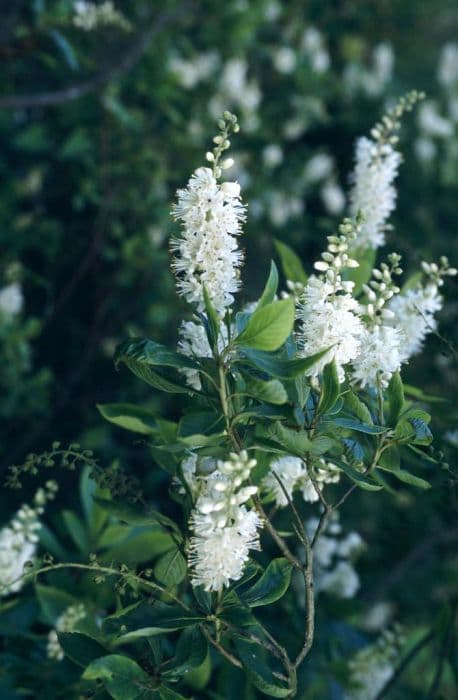Summersweet Clethra alnifolia 'Sixteen Candles'

ABOUT
The plant known as 'Sixteen Candles' Sweet Pepperbush is a compact, densely branched shrub that displays an upright habit. Its most striking features are the long, candle-like spikes of creamy white flowers that bloom in mid to late summer. These fragrant blossoms are highly attractive to pollinators like bees and butterflies. The flowers are aptly named for their strong vertical shape, reminiscent of lit candles. The foliage of 'Sixteen Candles' Sweet Pepperbush is a glossy green, with leaves that have a slightly wrinkled texture and finely toothed margins. In fall, the leaves may take on lovely shades of yellow or golden brown, adding to the visual interest of the plant. The bark on the stems is smooth, adding a subtle texture to the plant's appearance, especially during the winter months when the leaves have fallen. Overall, the plant presents a lush, robust appearance that can serve as an attractive addition to gardens and landscapes.
About this plant
 Names
NamesSynonyms
Summersweet, Sweet Pepperbush, Coastal Sweet Pepperbush, Summer Sweetcloth, Alder-leaved Clethra, Sweet White Alder.
Common names
Clethra alnifolia 'Sixteen Candles'.
 Toxicity
ToxicityTo humans
Summersweet is generally considered non-toxic to humans. There are no significant reports of toxicity or poisonous effects from ingesting any part of this plant. Therefore, accidental ingestion of Summersweet is not expected to cause any symptoms of poisoning or severe consequences for humans.
To pets
Summersweet is not known to be toxic to pets. There are no widespread reports of illness or poisoning in pets such as dogs and cats from ingesting this plant. Ingestion of Summersweet should not cause any significant symptoms of poisoning or adverse health consequences in pets.
 Characteristics
CharacteristicsLife cycle
Perennials
Foliage type
Deciduous
Color of leaves
Green
Flower color
White
Height
3-4 feet (0.9-1.2 meters)
Spread
2-3 feet (0.6-0.9 meters)
Plant type
Shrub
Hardiness zones
4-9
Native area
North America
Benefits
 General Benefits
General Benefits- Attracts Pollinators: The sweetly scented flowers of Clethra alnifolia 'Sixteen Candles' often attract bees, butterflies, and other beneficial insects, promoting pollination.
- Ornamental Appeal: With its upright, candle-like flower spikes, lush green foliage, and vibrant yellow fall color, it adds significant ornamental value to the landscape.
- Low Maintenance: Once established, this plant is relatively low maintenance, requiring minimal care beyond occasional watering and pruning to maintain shape.
- Tolerates Wet Soil: It thrives in damp conditions where other plants might fail, making it ideal for wetland gardens or areas with poor drainage.
- Native Species: As a native plant to North America, it supports local ecosystems and is generally more adaptable to regional climate and soil conditions.
- Deer Resistant: This plant is not a preferred food source for deer, which can help to reduce damage in gardens located in deer-prevalent areas.
- Compact Size: The 'Sixteen Candles' cultivar is relatively compact, making it suitable for smaller gardens or as a part of mixed borders without overwhelming the space.
 Medical Properties
Medical PropertiesThis plant is not used for medical purposes.
 Air-purifying Qualities
Air-purifying QualitiesThis plant is not specifically known for air purifying qualities.
 Other Uses
Other Uses- Wildlife Habitat: Sweet pepperbush provides a natural habitat for birds and beneficial insects.
- Butterfly Garden Plant: Its flowers are a nectar source for butterflies, making it ideal for butterfly gardens.
- Natural Deodorizer: The flowers can be used in small bouquets to naturally freshen indoor air with their pleasant fragrance.
- Soil Erosion Control: Its dense root system can help stabilize soil, thus controlling erosion on slopes.
- Privacy Screening: Tightly planted, sweet pepperbush can form a dense screen for privacy in residential gardens.
- Thematic Garden Design: Can be used in colonial or historical garden designs to offer period-accurate landscaping.
- Rain Garden Plant: Due to its tolerance for moist soil, it's an appropriate choice for rain gardens.
- Educational Tool: Can be used in schools to teach students about plant pollination and native species.
- Cultural Significance: Sweet pepperbush may be used in landscaping to represent regions where it naturally occurs, such as the eastern US.
- Seasonal Interest: Provides winter interest with its dried seed capsules after the plant has flowered.
Interesting Facts
 Feng Shui
Feng ShuiThe Summersweet is not used in Feng Shui practice.
 Zodiac Sign Compitability
Zodiac Sign CompitabilityThe Summersweet is not used in astrology practice.
 Plant Symbolism
Plant Symbolism- Sweetness: Clethra alnifolia 'Sixteen Candles', commonly known as Summersweet, has fragrant flowers that can symbolize the sweetness or pleasant moments in life.
- Attraction: Its sweet scent is known to attract pollinators like bees and butterflies, which can represent attraction and magnetism in a metaphorical sense.
- Transformation: As Summersweet blooms in the heat of summer, it is often associated with growth and transformation through the changing seasons.
- Rarity: Summersweet is a unique variety with specific qualities, symbolizing uniqueness or rareness in certain contexts.
- Beauty in Simplicity: The simple beauty of the plant, with its understated flowers, can symbolize the idea that true beauty often lies in simplicity and natural charm.
 Water
WaterSummersweet 'Sixteen Candles' prefers consistently moist soil, so water deeply once a week, providing about 1 to 1.5 gallons of water per plant. During hot or dry spells, watering frequency should increase to twice a week. In cooler temperatures or rainy periods, reduce watering to prevent waterlogging. Ensure the soil is damp 2 inches below the surface, as proper watering encourages deep root growth and plant health. Adjust the amount based on rainfall, as too much water can lead to root rot.
 Light
LightSummersweet 'Sixteen Candles' thrives best in full sun to partial shade. The ideal location is one where it receives at least four to six hours of direct sunlight per day, which promotes better blooming. It can also grow well in dappled sunlight, making it suitable for planting under lightly spaced trees or on the north side of a building where it will receive ample sunlight without the heat of the midday sun.
 Temperature
TemperatureSummersweet 'Sixteen Candles' is hardy and can survive in temperatures as low as 0°F and as high as around 90°F; however, it prefers moderate conditions. The ideal temperature range for this plant is between 60°F and 75°F. While it is cold-tolerant, prolonged exposure to extremely high or freezing temperatures can be detrimental to the plant's health.
 Pruning
PruningSummersweet 'Sixteen Candles' should be pruned to maintain shape and encourage robust growth. Prune in late winter or early spring before new growth starts, removing any dead or damaged branches. Light pruning can also be done immediately after flowering to shape the plant and encourage new blooms for the next season. Pruning should be done annually, or as needed, to maintain the desired size and shape of the plant.
 Cleaning
CleaningAs needed
 Soil
SoilSweet Pepperbush, commonly known as 'Sixteen Candles' Clethra alnifolia, thrives best in a soil mix that is rich in organic matter, well-draining, and slightly acidic to neutral (pH 5.5 to 7.0). A blend of peat, compost, and perlite or pine bark can create an ideal environment, ensuring it retains moisture without becoming waterlogged.
 Repotting
RepottingSweet Pepperbush, also known as 'Sixteen Candles' Clethra alnifolia, being a shrub, is not commonly repotted and is usually planted directly in the ground. If grown in a container, repotting every 2 to 3 years is sufficient or when it outgrows the pot.
 Humidity & Misting
Humidity & MistingSweet Pepperbush, known as 'Sixteen Candles' Clethra alnifolia, prefers moderate to high humidity levels. It can tolerate some degree of humidity variation, but consistently high humidity will promote the healthiest growth.
 Suitable locations
Suitable locationsIndoor
Grow Sweet Pepperbush indoors with bright indirect light and ample humidity.
Outdoor
Plant Sweet Pepperbush in partial shade, moist soil, and mulch.
Hardiness zone
4-9 USDA
 Life cycle
Life cycleSummer sweet 'Sixteen Candles' begins its life cycle as a dormant seed, requiring stratification to break dormancy and germinate. After stratification, the seed sprouts in the spring, emerging as a seedling with a basic root system and shoot. As it matures, the plant develops into a dense, rounded shrub, with glossy green foliage and sturdy woody stems. During the summer, typically in July and August, it produces upright clusters of fragrant white flowers that attract pollinators. After pollination, the flowers give way to seed capsules that eventually release seeds in the late fall to complete the reproductive cycle. Throughout the seasons, the shrub experiences cycles of growth, flowering, and dormancy, particularly in colder climates where it loses leaves and enters a period of winter dormancy before regenerating in the spring.
 Propogation
PropogationPropogation time
Summer
The sweet pepperbush, also known as Clethra alnifolia 'Sixteen Candles', is commonly propagated by softwood cuttings. The best time for taking cuttings is in late spring to early summer when new growth is still tender and green. To propagate, one should cut a 4- to 6-inch long stem from a healthy plant, just below a node. The cut should be at a 45-degree angle to maximize the area available for root development. The leaves on the lower half of the cutting should be removed and the cut end dipped in rooting hormone to encourage root growth. The cutting can then be placed in a well-draining soil mix, ensuring at least one node is buried where roots can form. The pot should be kept in a warm, humid environment with indirect light until the cuttings have rooted, which typically takes several weeks.




